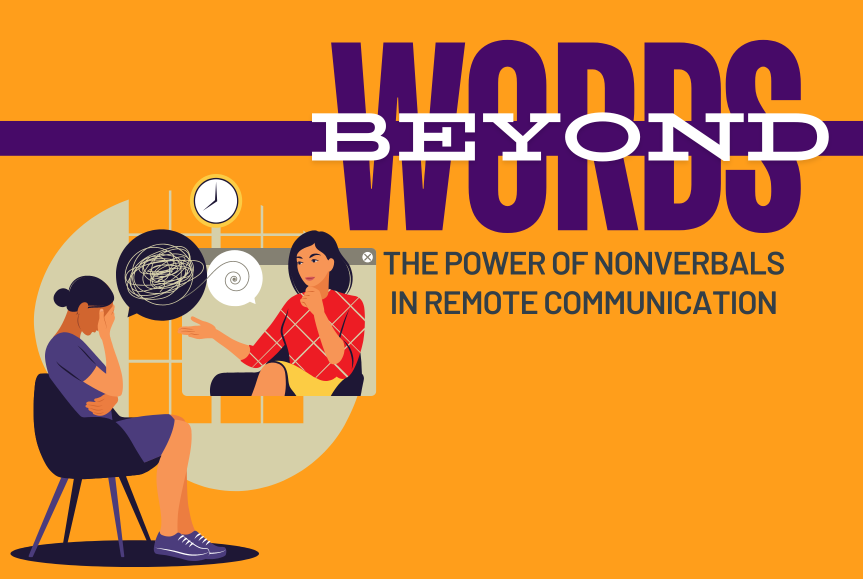
Last week, I was on a Zoom call with one of my coworkers, who was my previous direct leader. At one point during the call, she cocked her head to the side, looked directly at me, and asked a simple question: “How are you doing?”. Earlier that morning we had been on a different call with a few other people, and she noticed that something seemed off with me. Her observation had nothing to do with the words I used, it was simply based on the nonverbals I was conveying through the screen.
When she followed up during our second call that day, my instinct was to respond quickly by telling her, “I’m alright.” Knowing me and recognizing that my nonverbals were telling a different story, she pressed a little bit more by asking again about how I was doing. After being prompted a second time, I opened up and began to tell her about a few things that were frustrating me throughout that day. Venting to her helped me recalibrate, and she was even able to help me think of a few next steps I could take to address some of the things that were bothering me.
My interaction with my coworker doesn’t sound too profound, but it got me thinking about what happens when the expressions on my face don’t match the words that come out of my mouth. In this instance, she was concerned about my well-being, and potentially even my satisfaction with work, and my initial resistance to sharing all of the things that were on my mind did not help to ease her concern. There have been other times when people have thought I’m mad at them because I’m hesitant to share what’s on my mind, and my nonverbals convey that clearly something is wrong. This lack of alignment between what I share with my words and what I express on my face can create tension within my relationships if it goes unfixed. So – how do we ensure that our words reflect the truth behind our nonverbals?
The Integral Role of Nonverbal Communication
As you might recall from Our Community Listens, we spend time discussing the significance of ensuring there is alignment between all parts of communication: not just your words, but also your tone and your nonverbals (including facial expressions, gestures, movement, and body positioning). An article from the American Psychological Association quotes Dacher Keltner, PhD, saying “Our appearances and actions often say more about our feelings than our words. Even the smallest gesture — such as a head-tilt or a smile — can reveal a lot”. I’d have to agree! Our emotions travel with us regardless of where we are or what we are doing.
Navigating Emotional Honesty in Conversations
Sometimes we have the luxury of knowing a conversation is coming before it begins, like when you have a meeting scheduled. If you know the conversation is coming, take some time to pause and identify your emotions before beginning. This makes it easier to be intentional with your words when you are in the conversation. If you get asked about the nonverbals you convey and the emotion behind them, you’ll be more prepared to be able to name them. Your increased awareness will allow you to speak to your nonverbals without letting them hijack the conversation.
Other times, you might be in the middle of the conversation when your emotions are rising and your nonverbals are sending a message to the other person. In this situation, consider a few things.
Can you share the reason behind your emotions? Doing so can often build trust and connection. If you are at all like me, this is often very difficult to do! I am naturally inclined to hold “negative” emotions close to me and avoid sharing them with others, but doing so makes others wonder what’s going on with me and prevents my ability to get help through venting.
If you would prefer to not share the reason behind your nonverbals, consider what you could say instead. Let’s think back to my interaction with Katie. In that situation, I decided to share what was on my mind and vent out the things that were bothering me. If I wasn’t ready to share with her, I could have said something along the lines of “You’re right, I’m upset right now. I need to spend some time processing, but I appreciate you checking in” or “Thanks for asking. I don’t really want to talk about it right now, but I’ll let you know when I’m ready to”. Responding with something like this acknowledges that a) you are, in fact, experiencing an emotion, and b) they are correct in their observation. As the person with the problem, it also keeps ownership of the problem with you until you are ready to share it.
Often, when we talk about nonverbals, we spend time discussing how you can change your nonverbals to be more aligned to the message you want to send. I would like to propose the opposite – changing your words to match the inherent truth that is naturally conveyed through your nonverbals. We can make our communication clearer and more direct to those we care about by ensuring the words we use reflect the way we feel.
